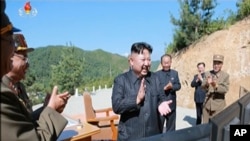North Korea said it has successfully carried out the launch of an intercontinental ballistic missile, a crucial milestone in Pyongyang’s efforts to develop its nuclear weapons capability, despite repeated international warnings to the contrary.
The missile, which was launched from an airport near China’s northeastern border with North Korea, landed in Japan’s special economic zone, sending shockwaves through Tokyo’s political establishment and confirming Beijing’s inability to keep Pyongyang in check.
Two U.S. officials said the U.S. believes it was an intercontinental ballistic missile that North Korea tested Monday night.
The launch of the missile that North Korea claims can “hit anywhere in the world” will put additional pressure on Beijing to impose even tougher sanctions on Pyongyang. How it will ultimately respond is unclear.
The launch of the missile that North Korea claims can “hit anywhere in the world” will put additional pressure on Beijing to impose even tougher sanctions on Pyongyang. How it will ultimately respond is unclear.
At a regular news briefing Tuesday, China’s Foreign Ministry spokesman Geng Shuang said Beijing has made “relentless efforts” to resolve challenges on the Korean peninsula. He also said China’s role is “indispensible” and called on all parties to exercise restraint to quickly ease tensions.
“[China] urges North Korea to refrain from acts that violate U.N. Security Council resolutions and instead create necessary conditions for resuming dialogue and negotiations,” Geng said.
Trump criticizes launch
Trump has been trying to get China to do more to put an end to North Korea’s nuclear weapons ambitions, but late last month he said that while he “greatly appreciated” the efforts of President Xi Jinping and China to help, “It has not worked out. At least I know China tried!”
Even so, he renewed his call for more pressure from Beijing earlier on Tuesday in a Tweet shortly after the launch, but before North Korea said it was an ICBM. Trump said that “perhaps China will put a heavy move on North Korea and end this nonsense once and for all!”
Commenting on North Korean leader Kim Jong Un he also said, “Does this guy have anything better to with his life? Hard to believe South Korea and Japan will put up with this much longer.”
And the U.S. Pacific Command said it is working with its interagency partners to assess and monitor North Korea's actions.
On Tuesday, Japan’s Prime Minister Shinzo Abe said the latest missile test shows the North Korean threat has increased.
Later this week, the United States, South Korea and Japan will hold a trilateral meeting on the sidelines of the Group of 20 Nations summit in Hamburg, Germany.
“I will also ask (Chinese) President Xi Jinping and (Russian) President (Vladimir) Putin to respond in a more constructive way,” he added.
What will China do?
Cheng Xiaohe, a political science professor at Beijing's Renmin University, said that while it is still too early to tell what steps China might be willing to take or whether the United Nations will respond by only condemning the launch or enact a new round of sanctions.
“If new sanctions are enacted it should include new measures, such as a ban on North Korea-bound tourism, and bans on North Korean petrochemical products,” Cheng said. “All of these are possible measures the Security Council could discuss.”
Cheng said that more research of the launch is needed, but that appears to be a missile with the capability of traveling up to 10,000 kilometers. During the test, the missile climbed 2,800 kilometers before plunging in the sea.
David Wright, a physicist and co-director of the Union of Concerned Scientists said in a blog online that if reports are correct, the same missile could have a maximum range of roughly 6,700 km on a standard trajectory.
"That range would not be enough to reach the lower 48 states or the large islands of Hawaii, but would allow it to reach all of Alaska," Wright said.
Joyce Huang contributed to this story in Washington






